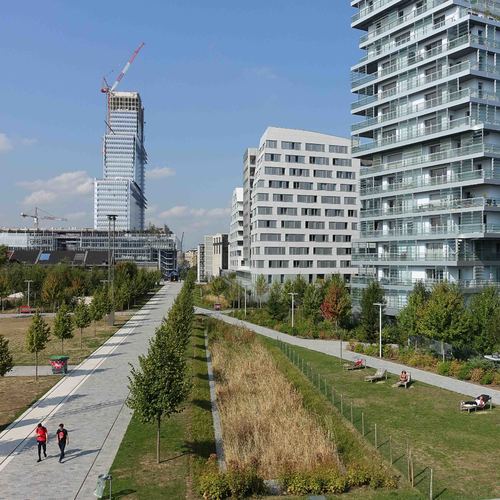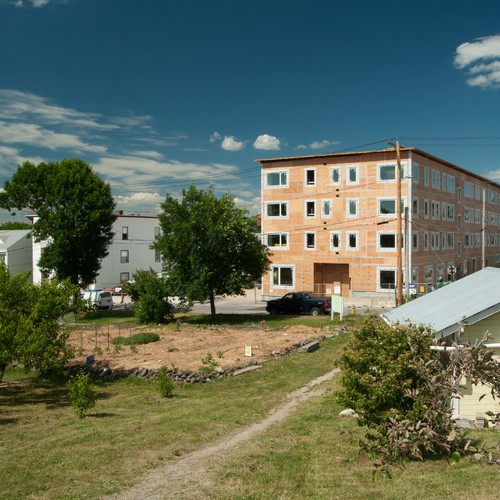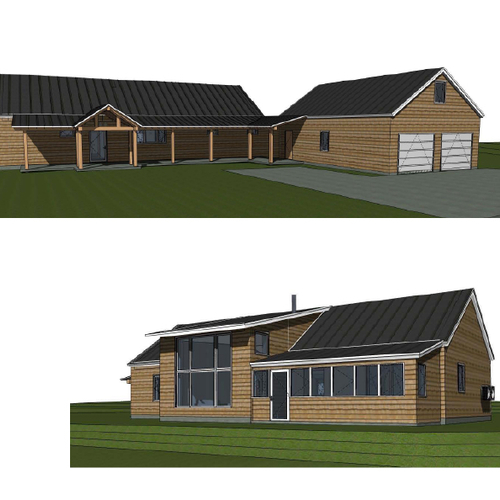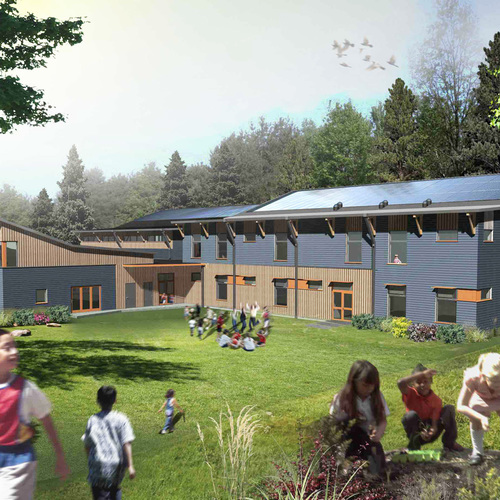Image Credit: All images: Samuel Strickland for Platinum Green Inc.
Image Credit: All images: Samuel Strickland for Platinum Green Inc. Souler House is equipped with a 3.6 kWh Kyocera photovoltaic system. VaproShield house wrap with vertical strapping for the rain-screen wall.
Jason Peacock wants to build houses that impart the benefits of green building to the people who occupy them, and he took a major step in that quest last fall with the completion of a 950-sq.-ft. two-bedroom in Wiscasset, Maine, a village on the Sheepscot River, northeast of Portland.
Peacock is a LEED Accredited Professional, and the house, which he hopes will be the first of at least four he wants to build on 36 wooded acres he owns in Wiscasset, includes a photovoltaic system and design, materials, and construction intended to conform to LEED for Homes Platinum criteria.
Small house on a spacious lot
Called Souler House, it features a frost protected shallow foundation (a foundation system commonly used in Scandinavian countries; click here for a primer on the subject produced by the National Association of Home Builders Research Center), 2×6 exterior walls insulated to R-25 with open-cell spray foam. Peacock installed a VaproShield permeable moisture barrier and used fiber-cement board and a rain-screen wall.
The ceiling is insulated to R-50 and the standing-seam roof is recycled aluminum. Air leakage is minimal: a blower-door test showed 1 air change per hour at 50 Pascals pressure difference. Peacock also used plenty of reclaimed material, including wood around the front door, which, notes a website called Green Homes of Maine, he salvaged from an airplane hangar.
An air-to-air heat pump, Convectair electric heaters, and a Regency wood stove help keep the building comfortable in winter, and a 3.6 kWh Kyocera photovoltaic system supplements the home’s electrical needs.
Looking ahead
Peacock told Green Homes he plans to make photovoltaics, LEED Platinum criteria, and the performance level of the house standard for all of the other homes he builds at the Wiscasset site, adding that he might offer some of them for sale or rent them to seasonal visitors. In an email to GBA, Peacock noted that the weekly off-season rental rate will be $800, and the peak-season rate will be $1,200.
So far, he told GBA, he has sold three lots on the site, although because of still-lagging economic conditions he doesn’t expect building on those lots to commence until 2013. But if the rental business on Souler House is robust enough over the summer, he might build another house for himself. Souler House, he added, was appraised last year at $195,000, including the 36-acre site.
Like Souler House, the other houses he builds on Wiscasset likely will be small and solar-powered.
“I do like the small-house movement and I strongly believe that life is better when you have less stuff,” he said. “So my next home will potentially be smaller with a large decks to enjoy outside spaces and views. It’s not a requirement for the community, but all the homes will probably be 1,000 square feet or less. I’ve been working on a design for a 650 square foot, two bedroom home that I’m excited to build. These houses will be great for people that believe that ‘Less is More…’ ”
Weekly Newsletter
Get building science and energy efficiency advice, plus special offers, in your inbox.
















8 Comments
Small effecient homes
Have you ever considered SIP (building) panels for the construction method on your designs? Someone did a presentation for our group recently on them, as we have a 20 piece of land in upstate NY that we were considering building some permanent and temporary structures on. The panel (sip) method,which according to the rep, can be used without the conventional rafters and floor joists in the construction of the structure? Seem to good to be true and he touted a lot of other advantages as well to going with that type of const. Any thought or advise would be appreciated!
Response to Jan Olsen
Jan,
You know what they say about anything that "seems too good to be true" ...
SIPs are an excellent system for building homes, but they cost significantly more than other systems (some of which perform just as well as or better than SIPs).
If you perform a search here at the GBA site for "structural insulated panel" or "SIP," you'll get lots of information on this building method.
The Souler House
I wanted to mention that the rafters were thermally broken with an R-13 Bonded Logic batts (denim) and the walls were thermally broken with a product called Slab Shield. The HRV is also a very important part of this house. I choose a Venmar, Kubix, which only uses 24 watts of electricity at low speed and can be programmed to run with custom intervals based on occupant’s behavior. I think one thing that sets this house apart is the house wrap (Vapro Shield - perm rating of 212) and rain-screen wall detail with fiber cement board. It will make the siding last 4 x longer (by allowing it to dry out) without having to repaint it every 5-10 years. I also wanted to mention that there are no VOCs or Formaldehyde in the house. All of these products were sourced at Maine Green Building Supply in Portland, Maine. Lastly, I will be installing a mini-split heat pump (Fujitsu Model AOU9RLS2) and will be near Net Zero with the 3.6 kW of PV.
Wall material and rain screen
This project sounds like a pretty cool venture and I wish you luck with it.
I'm curious as to the bathroom wall materials and method (vapor barrier & hardibacker, MgO board, ??). Also, what type of drywall, if any, was used in the remaining rooms (purple stuff, etc.??).
Secondly, I guess I'm not up to speed, but what exactly is a rain screen wall detail?
Thanks.
Materials
Looks like a very cool project. I am very interested to hear how the HERS rating comes out. I looked up the slab shield and was interested in how you used it? Did you wrap the exterior walls with it between your WR barrier & the sheathing?
I am also a big fan of the frost protected shallow foundation. Did you also use under-slab insulation in addition to the insulation on the outside of the footing/slab and the horizontal leg of rigid?
Thanks.
Q & A
In response to questions:
The Slab Shield was cut into 3" strips and stapled to the interior of the studs. I didn't want to have a vapor barrier, so running it continuously wouldn't have worked. I used 24" on center advanced framing techniques to lessen the amount of wood in the wall.
The blower door test was my measure of performance ( 1.0 @ ACH 50 ) I choose not to do a full HERS rating because many of the things I have in the house are not applicable to HERS. If they don't have your specific detail, then you get selected as the average option. Therefore a house with so many unique features isn't fairly measured on the HERS scale.
The FPSF (Frost Protected Shallow Foundation) link that Richard included in the above article is actually what I used to design my slab. I did use rigid insulation under slab and on the vertical portion with "wings" around the whole perimeter (2' on lengths, 4' at corners).
Deniz - I used regular Hardi backer board for the shower walls. They have a mold resistant board that smells like a toxic dump, so I avoided that product. I used the Vapro Shield product behind it so to protect insulation. It won't allow moisture through it, but will allow vapor to dry to it's front side. I used non-poly blended thin set for the slate tile. Then I sealed it with a soy based no VOC product called Eco Pro Cote. I used green board drywall in the rest of the bathroom. I have a Whisper Green Panasonic vent fan for moisture mitigation in both bathrooms and also the HRV helps mitigate moisture. I used Murco hypoallergenic mud compound. The majority of the house if finished with 5/8 drywall and Murco mud. I am familiar with the MgO board, but choose to not use it for various reasons. I finished walls with American Clay plaster and Yolo Paint. Yolo is not only zero VOC, but does not contain antifreeze, like all other paint manufacturer's VOC free options.
The rain-screen wall detail is seen in the in progress photo in this article it shows vertical strapping that allows a 3/4" air space between siding and house wrap. I used pine that I treated with a product called Cedar Shield, which wicks through the wood embedding cedar oil and silicone into each cell. It changes the cell structure and makes the wood impervious to rot and bugs. I used a product called Cor-a-vent on all of the horizontal breaks, which keeps bugs out but lets air flow.
Congratulations
Jason,
Congratulations on the post. Having seen the house in its unfinished state, it's great to see and hear some of the finish details.
Roof
A beautifully designed accomplishment! Thanks for sharing all the info.
I have been researching vented vs unvented roof assemblies for a project in Nova Scotia - how did you achieve the R50 stated for your roof?
Log in or create an account to post a comment.
Sign up Log in